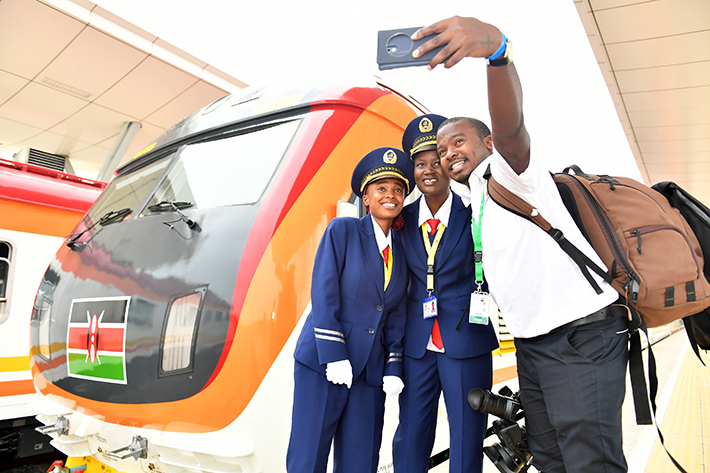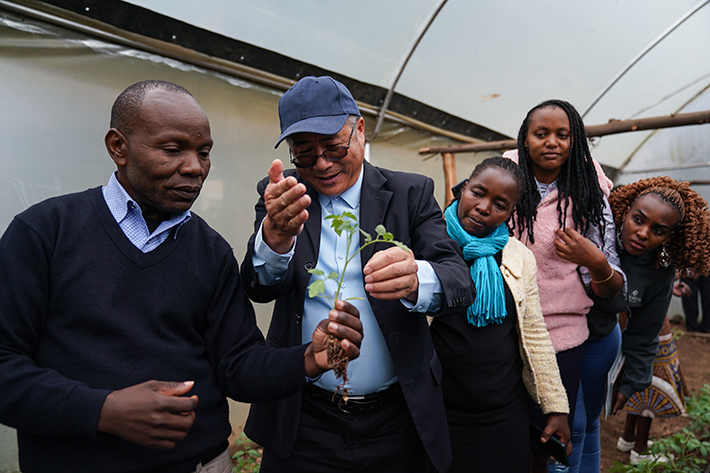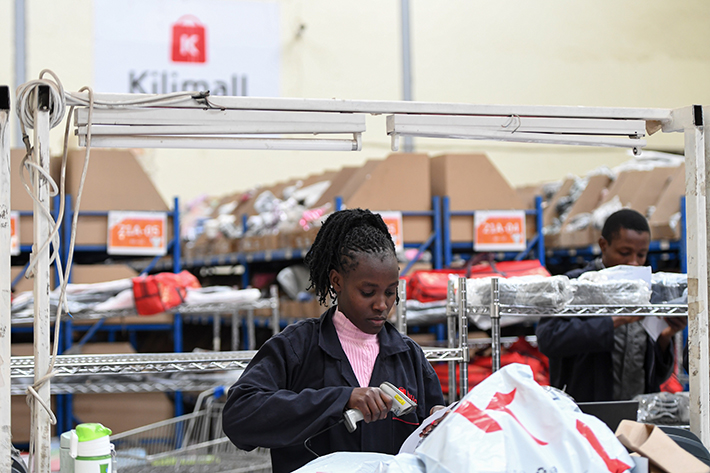|
||||||||||
| Home Nation World Business Opinion Lifestyle ChinAfrica Multimedia Columnists Documents Special Reports |
|
||||||||||
| Home Nation World Business Opinion Lifestyle ChinAfrica Multimedia Columnists Documents Special Reports |
| ChinAfrica |
| Vital Links |
| China-Kenya partnership has played an important role in advancing economic growth in the African country over the last 60 years |
| By Xia Yuanyuan | VOL. 15 December 2023 ·2023-12-01 |

A Kenyan journalist (right) takes selfies with train drivers during the launch day of the Mombasa-Nairobi Standard Gauge Railway in Mombasa, Kenya, on 31 May 2017
The year 2023 marks the 60th anniversary of the establishment of diplomatic relations between China and Kenya. Over the past 60 years, the two sides have always trusted and respected each other, and closely cooperated in diverse fields. On this important occasion, ChinAfrica interviewed Dennis Munene, executive director of the China-Africa Centre at the Africa Policy Institute and a PhD candidate at UCASS, to hear his views on the development of China-Kenya relations. Edited excerpts of the interview follow:
ChinAfrica: What, in your opinion, have been the most significant developments in China-Kenya relations during the last 60 years, and how should the relationship move forward?
Dennis Munene: As Kenya and China mark 60 years of fruitful diplomatic relations, the two countries have implemented both signature or mega projects and “small yet smart” projects that have transformed the lives of Kenyans in a big way. Projects in the sectors of housing, manufacturing and industrialisation, health, digital economy, smart and clean energy and other fields have helped Kenya to achieve its quest for sustainable modernisation.
The construction and launch of the Thika Super-Highway on 9 November 2012 became a key driver of Kenya’s transformation into a strong economic hub for the region and beyond. The highway has certainly provided a reliable transport corridor in Kenya.
Also, the construction and the completion of the approximately 27 km Nairobi expressway that is linking the Jomo Kenyatta International Airport and the Nairobi Central Business District is the first real toll road in Kenya, and a pioneer model of a debt-free project between China and Kenya in the field of infrastructure development. Also, we have seen the expansion of the Nairobi Outer Ring Road Improvement Project that links the Nairobi-Thika Superhighway to the Nairobi-Mombasa Highway, and the construction of the Kibwezi-Usueni Highway and the Southern and Northern bypasses.
Other than the upgrading and expansion of roads in Kenya, China has also rekindled and modernised the old dream of a transcontinental railway network needed to connect ports on the Indian, Atlantic, Red Sea and Mediterranean Coasts. Anchored on Agenda 2063 to transform Africa into a global powerhouse of the future, the dream of creating a modern continental railway network to accelerate regional integration and boost its competitiveness in a globalised world gave rise to Kenya’s Standard Gauge Railway (SGR) system.
The goal of the construction of the SGR is to provide the most efficient way to move people and goods. It has been achieved through 600 km of completed railroad between Mombasa and Naivasha. The railroad provides low-cost, comfortable, faster and safe passenger transport and efficient cargo movement between Nairobi and Naivasha. On average, six passenger trains are operating daily, carrying 7,000-10,000 people per day, equivalent to about 145 commuter buses. It now takes about five hours by express train and six by intercounty train between Nairobi and Mombasa, compared to between eight and 12 hours by bus.
The SGR has also created employment and boosted industrialisation and manufacturing. A new wave of urbanisation is sweeping through the SGR corridor. Towns and villages that were once uninhabitable are breathing life again, due to the various SGR stations. The SGR has enabled social mobility and cultural exchange in Kenya, becoming an enabler of peace and development.
Other significant projects that China has done over the past 60 years include the construction of the Thwake Multi-Purpose Dam, the Karimenu II Dam, the New Kipevu Oil Terminal, the Garissa 50 MW Solar Plant, the Lamu Port (berths 1-3), and the Global Trade Centre.
These signature projects are just a few examples of what China has done in Kenya. The China-Kenya partnership has also enhanced cooperation on policy coordination, trade promotion, financial connectivity and people-to-people exchanges.

Liu Gaoqiong (second left), a Chinese professor of agriculture, instructs students on tomato planting at a greenhouse in Nakuru County, Kenya, on 18 September
What is the significance of infrastructure construction projects represented by the Mombasa-Nairobi SGR in promoting the overall economic development of Kenya?
The Mombasa-Nairobi SGR has boosted Kenya’s economic growth, created efficiency and employment, and raised the level of the manufacturing and industrial sectors.
In terms of economic growth, in 2022, the SGR generated $95.5 million in earnings, up from $91.8 million in 2021, according to the figures given by Kenya Railways Corp., 1.5 percent of the country’s GDP growth is attributed to the SGR project. It has accelerated the implementation of Kenya’s Vision 2030, the country’s framework for development and economic growth. It is estimated that “the SGR will contribute 2 to 3 percent of Kenya’s GDP,” Philip Jamuhuri Mainga, managing director of state-owned enterprise Kenya Railways Corp., was cited by Xinhua News Agency as saying.
The SGR is already boosting industrialisation and manufacturing in a range of areas such as steel, cement and agriculture in Kenya. The railway has provided a fast, efficient and affordable mode of transport for goods from the port of Mombasa to other parts of the country and neighbouring countries. The volume of cargo handled by the Mombasa-Nairobi SGR has increased steadily from 2.93 million tonnes in 2018 to 6.26 million tonnes in 2022. In 2023, the SGR is projected to have a freight volume of approximately 6.8 million tonnes, according to Kenya Railways Corp.
This has significantly boosted the economic growth of Kenya, making the SGR a key agent of sustainable development.
Since its launch in June 2017, the SGR has employed approximately 2,700 Kenyans. Over 2,285 employees with different professional backgrounds are working at the 33 stations of the railway and on the passenger and cargo trains. Many more are employed indirectly. In the wake of its construction, the SGR project has created a total of 30,000 new jobs. At the construction stage, the Mombasa-Nairobi section of the SGR employed more than 46,000 local residents. More than 1,000 local companies were enlisted in the building of the railway at different levels. This has direct effect on Kenya’s economic growth.
The SGR has also generated tourism revenue. The SGR itself is a marvel, attracting both local and foreign tourists. Tourists also prefer this affordable, safer and faster mode of transport. Passengers can see Mount Kilimanjaro and wildlife animals while crisscrossing Tsavo National Park from the comfort of their SGR seat as they travel to the coastal city of Mombasa from Nairobi. This has led to the flourishing of the hospitality industry on the coast while contributing to the development of regions along the route.
What is the Kenyan public’s perception of the Belt and Road Initiative (BRI)?
As a global “public good,” the BRI has become the greatest proponent of equality among civilisations at a time when countries in the Global North are advancing policies of anti-globalisation and nationalism. This was witnessed during the COVID-19 period when China took up the mantle of global leadership with clear strategy and foresight to help the world to win the fight against the pandemic through the promotion of the Health Silk Road and provision of vaccines to developing countries such as Kenya.
For this reason, Kenyans have praised and appreciated the impact of the BRI since it was launched in 2013 by President Xi Jinping. As a transformative initiative, Kenya has seen positive and fruitful results of the BRI in the last 10 years. Today, Kenya is enjoying high-quality infrastructure projects such as the Nairobi Expressway - a 27.1-km road built by a Chinese firm under a public-private partnership model. That has debunked the debt trap propaganda. Kenya has also seen the construction of a number of important projects as listed before. These projects have enabled Kenya to become a frontier of sustainable development in the region.
Most Kenyans understand the BRI through the infrastructure development projects that have transformed the country in a big way.

Staff members of Kilimall work at a warehouse in Mlolongo, Kenya, on 28 July
How important is the BRI to align the initiative with Kenya’s Vision 2030 plan?
The Kenya Vision 2030 plan is a long-term development blueprint that aims to transform our country into a newly industrialised, middle-income country by the year 2030. The plan focuses on economic, social and political pillars to achieve its objectives.
On the other hand, the BRI is a global strategy initiated by President Xi to connect Asia with Africa and Europe via land and maritime networks with the aim of improving regional integration, increasing trade and stimulating economic growth. These two initiatives or strategies have helped Kenya to grow and develop economically. For example, BRI has enabled Kenya to enjoy world-class infrastructure development. It has enabled the country to grow economically, aligning well with Kenya’s Vision 2030.
What’s your comments on the Global Development Initiative proposed by China?
The Global Development Initiative (GDI) is assisting the global community and the United Nations to achieve the 2030 Sustainable Development Goals, the African Union to achieve its Agenda 2063 currently in its 10th year, and regional governments to achieve their national agenda such as Kenya’s Vision 2030 to reverse the devastating impacts of COVID-19 on development, address the challenges of environmental degradation and climate change, and promote green recovery and the principles of an ecological civilisation that harmonise development and natural environment.
African countries have embraced the GDI knowing that development begets freedom and justice. Evoking the spirit of Pan-Africanism and African Renaissance, the Agenda 2063 includes 20 goals for transforming Africa into a global powerhouse of the future. The GDI can help to make the Pan-African dream a reality.
Further, the GDI is committed to building a community with a shared future for humanity. The GDI is anchored on practical cooperation areas such as poverty reduction, food security and financing for development, issues that feature within the agenda 2063 and currently affect the continent of Africa. Together with the Global Security Initiative and Global Civilisations Initiative, the GDI will be the magic bullet that Africa and the world need to foster sustainable development.
| About Us | Contact Us | Advertise with Us | Subscribe |
| Copyright Beijing Review All rights reserved 京ICP备08005356号-5 京公网安备110102005860号 |